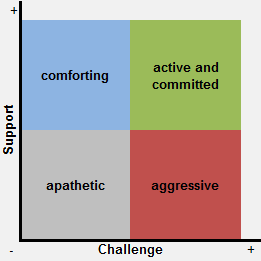following – noun – a body of supporters or admirers. (source: Oxford Dictionaries)
Leadership is not something bestowed on you from on high, it is something you only have by virtue of your followers and followers can be easily lost.
“The greatest leader is not necessarily the one who does the greatest things. He is the one that gets the people to do the greatest things.”
Ronald Reagan
It is a common misconception that leadership is something which is acquired by virtue of a promotion or by dint of having a particular role within the organisation. Whilst it is true that some roles require leadership qualities as part of the role, it is not the case that those qualities are present in everyone fulfilling a leadership role or that the result of appointment to such a role is automatically good leadership.
Being a leader implies that you have followers. It is followers that bestow leadership on an individual. It is true that, contractually, a leader’s direct reports may be required to follow (particularly evident in the military), however, followers who aren’t following willingly and enthusiastically will not be giving of their best and when push comes to shove may not be there to deliver.
A leader should first strive to be someone others can follow and to invest in relationships with followers. In this context, followers are not just your direct reports, but also your peers and those above you. Good relationships with those sideways and above you in the organisation chart are evidence of someone with good leadership potential. If those around you listen and act on your ideas then you are leading even if you have not been given the formal authority. Who is it more natural to promote and give that formal authority to than someone who is already demonstrating their potential to lead.
Sometimes someone other than the appointed team leader is actually leading the team more than the appointed leader. If a team has a lack of good leadership there will be a leadership vacuum and whoever is investing most in the relationships and gaining the respect of the team will be fulfilling leadership functions as an unofficial substitute, often outside the formal work structures or environment, often without wanting to undermine the appointed leaders, but unwilling to see the team fall apart.
To be a good leader, you need to be someone others can follow.
Be a good follower
Demonstrate good followership by being a good follower yourself. Set an example for others to follow. If you are undermining those in the organisation above you or if you have a generally cynical attitude to the goals or management of your organisation, then don’t be surprised if those beneath you are seeking to undermine you or are cynical about your leadership of them.
Even if you are at the top of the organisation, be sure to set a good example and to avoid cynicism.
This is not to say you shouldn’t challenge the organisation, your leaders or management. But, when you do so, do it in the appropriate forum at the appropriate time and avoid doing it in public or in a way that undermines others’ authority. When you challenge, be prepared to accept that you can’t always be right, to accept the disagreement if it can’t be resolved and to then back the organisation’s stance fully.
If you can’t accept an alternative strategy, stop and think about why not. You need to resolve this conflict if you want to continue fulfilling a leadership role in your organisation. It may be that the organisation’s strategy is at odds with a deeply held personal value. If this is the case, you may not be able to resolve the issue in which case it may be time to move on. If not, is it your pride that is getting in the way? Once the organisation’s strategy is set and you have had the opportunity to challenge, it is time to get behind the strategy and make it the right strategy through your actions and the actions of your team.
Adopt an attitude of realistic optimism. This will be attractive and believable to potential followers and will encourage them to adopt a similar attitude.
Be consistent and authentic
Followers are hard won and easily lost.
If you are seeking to be someone to follow, then you should be consistent in your attitudes, relationships and objectives. Obviously, goals will change from time to time. These changes need to be carefully communicated so you retain the respect of your team and do not come across as fickle.
You need to understand your own purpose and the organisation’s strategy and how these are aligned and help your team understand how they fit into that strategy and their purpose in driving the organisation forward.
Does your organisation have values which are consistent with your own values? Hopefully if you are in a leadership position in your organisation you can answer with a very definite yes. If not, you are likely to have some internal conflict and this will affect your attitude and demeanour and will make it harder for people to follow you.
If your values are in alignment with those of the organisation and your goals are aligned with theirs, you can be authentic in your leadership. An authentic individual will be more attractive to followers than someone seen as just acting out a role.
Build respectful relationships
Lasting relationships need to be built on a firm foundation of trust, openness and mutual respect. If you listen to your team, respect them and empower them. You will then start to get the best out of them. They in turn will appreciate and reciprocate that respect. Those you support to be their very best will in turn become your most ardent supporters.
Be someone who inspires others and helps them to get the best out of themselves.
Don’t seek authority
Telling your boss that you can’t get team members to do what you ask and that a promotion would give you the authority, in my view, is a mistake. What you are demonstrating is that your team do not follow you, that you do not have the full respect of team members or that you haven’t invested sufficiently in the relationships in your team. Does your boss want to give you authority if you haven’t invested in those relationships and developed them so that when you speak others listen? When others are already starting to view you as their leader and to follow you the promotions and formal authority will surely follow.
That isn’t to say you shouldn’t be ambitious, you absolutely should. But your ambition shouldn’t be to seek leadership positions for the sake of authority and power. Such ambition is unappealing and will not encourage followership. You may be seen to be fighting for power with your team. Be ambitious for achieving your goals and the goals of the organisation and for your own personal and professional development. Empower your team and encourage them to be their best. Your ambition will be taken as an example to follow, make sure you role model the right behaviours.
“Followers are more important to leaders than leaders are to followers.”
Barbara Kellerman

















